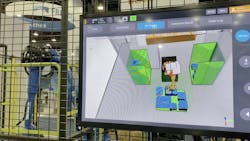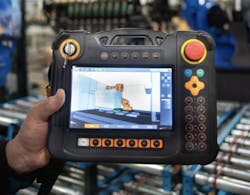Inside Mujin’s Robotics Operating System Technology
Why this article is worth reading:
- Learn about Mujin’s approach to using digital twin technology, real-time motion planning and AI-driven autonomy in its Mujin OS.
- Get insights on Mujin OS’s no-code robot deployment, autonomous decision-making and fleet coordination.
- Understand how the platform can be used to connect with existing infrastructure like WMS, ERP systems and PLCs.
Describing Mujin OS’s model-based digital twin technology for real-time motion planning, Mujin’s Josh Cloer said, “With Mujin OS, your robot, vision system and gripper are all set up in this digital twin environment so that you no longer have to tell the robot directly what to do. This means it can achieve its goals with autonomy.”
In the application shown at Automate 2025, 3D sensors are used to understand the status of the palette and the cages, with all data residing on the Mujin controller. Cloer explained this means users don’t need to program the vision system separately from the robot — it’s all done on the controller within Mujin OS.
The perception capabilities of Mujin OS incorporate advanced computer vision technology with autonomous calibration features. The vision system can automatically register stock-keeping units (SKUs) and perform real-time item detection, adapting to new objects and environments without manual configuration.
Mujin OS employs motion planning algorithms that generate real-time, collision-free paths for robotic movement. The motion planning component includes automatic recovery capabilities and obstacle avoidance functionality, enabling robots to navigate complex environments and recover from unexpected situations autonomously.
The orchestration capabilities within Mujin OS handle task scheduling, prioritization and execution across the robotic system. This component adapts to system constraints and changing operational requirements to ensure coordination between multiple robots and system components.
Application components Mujin OS includes several specialized application modules designed for specific functions, such as:
- Vision Manager handles tasks from SKU registration to providing real-time item detection functionality.
- Execution Manager oversees high-level order processing by interfacing with warehouse management systems (WMS) and coordinating tasks across the robotic installation to synchronize operations across multiple system elements.
- Fleet Manager coordinates multiple mobile robots through intelligent task management algorithms, enabling interoperability between different robotic units while maximizing overall fleet efficiency.
- Parts Manager maintains libraries of objects that robots manipulate to organize all elements within a single, accessible database.
- Controls Interfacing provides connectivity and control capabilities for safety devices, input/output systems, material handling equipment and programmable logic controllers (PLCs). This component feeds real-time operational data into the Digital Twin system for intelligent decision-making.
In the video below, Josh Cloer from Mujin explains Mujin OS and its digital twin capabilities.
The industrial robotics landscape has evolved significantly with the emergence of operating systems designed specifically for autonomous robotic operations. The Mujin OS robotics platform integrates artificial intelligence, real-time processing and advanced perception capabilities to enable autonomous robot functionality across diverse industrial applications.
Mujin OS operates on a no-code framework designed to eliminate traditional programming requirements for robot deployment. The system runs on the Mujin Controller hardware platform, which serves as the computational foundation for processing complex robotic tasks.
This architecture combines three primary technological components: 3D perception systems, real-time motion planning algorithms and dexterous grasping capabilities. The system's design philosophy centers on autonomous decision-making, allowing robots to analyze situations, adapt to changing conditions, and execute tasks without human intervention.
Key technology components of Mujin OS Central to Mujin OS is its digital twin technology, which creates a real-time virtual representation of the entire robotic system. This technology serves multiple functions within the operational framework, providing scene setup capabilities, continuous task monitoring and troubleshooting tools.
The digital twin operates using the same computational logic as the physical robotic system, ensuring that virtual simulations accurately predict real-world performance. This synchronization enables operators to design, test and optimize processes in the digital environment before implementing them in production settings. The system includes integrated playback functionality, visualization tools and analytics capabilities that provide detailed traceability and complete digitization of warehouse operations.
See Mujin OS used with a piece picking robot at the Askul Value Center Kansai, Japan, in the video below.


